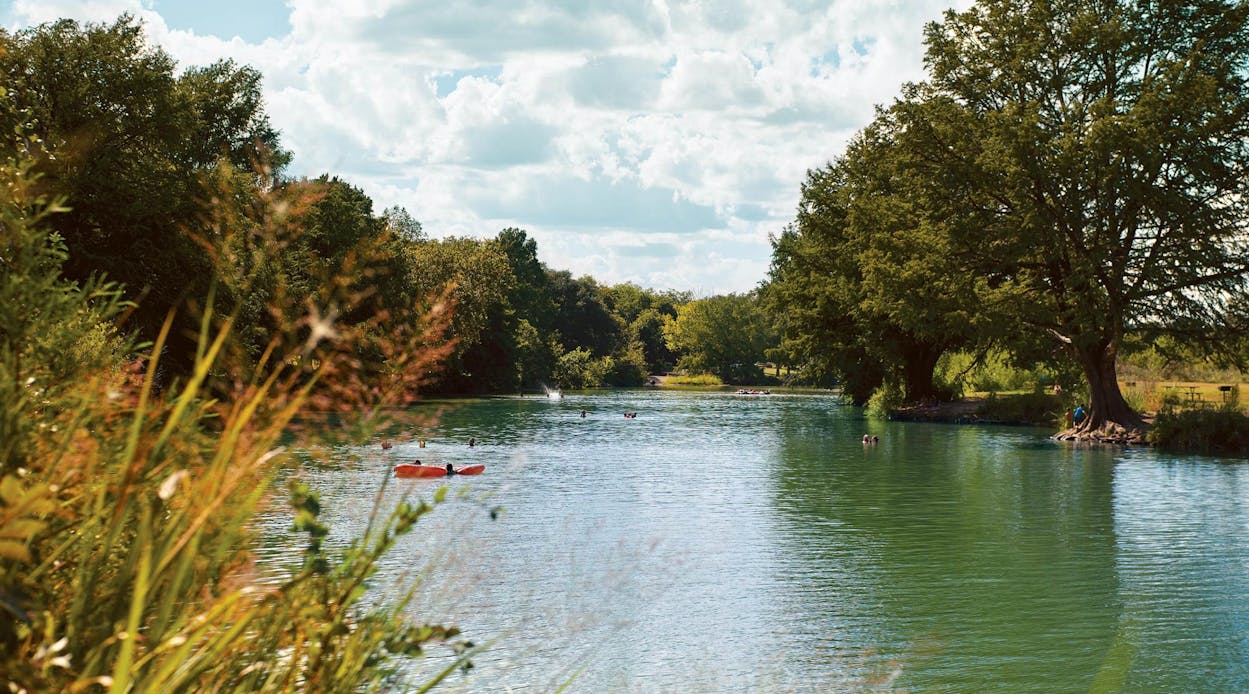I lived through the golden age of Texas swimming holes. Having spent my youth submerged in chlorinated pools in and around Fort Worth, I moved to Austin in 1973 and discovered Hippie Hollow before it was a county park and Barton Creek before a mining executive threatened to build a giant development along its banks.
Swimming in clear artesian spring water was a revelation to me. As a child, I’d seen San Marcos Springs when it was the Aquarena Springs theme park, but I didn’t associate the crystalline waters that Ralph the Swimming Pig frolicked in with something that was accessible to me. And yet, to my delight, I came to learn that they were.
The water in a Texas swimming hole is a pale blue or green or a hue somewhere in between that you can see through, often right to the bottom. Your eyes don’t sting when you open them underwater. There are creatures to observe—minnows, perch, crawfish, carp, catfish, bass, turtles, ducks, and maybe even, God help me, a water moccasin. A spring-fed swimming hole means cool-to-cold temperatures. The bottom is limestone, not squishy mud. Spoiled by such wonders, I quickly developed an aversion to cement ponds, as The Beverly Hillbillies’ Jethro Bodine called conventional swimming pools, and flinched at the scent of chlorine.
My then-girlfriend got me hooked on doing widths at Austin’s famous Barton Springs, and pretty soon I had worked up to swimming a round trip along the pool’s roughly one-eighth-mile length. Then it was a half mile and then a full mile. I was addicted. If I missed a day, I got cranky.
My search for clear, clean water turned into a treasure hunt. Hill Country rivers were prime targets: the Guadalupe, the Comal, the west fork of the Nueces, the Blanco, the San Marcos, the Llano, the Frio, the Medina. Creeks that fed the rivers sheltered hidden delights such as Jacob’s Well, Krause Springs, and several Blue Holes.
But I also found swimmable springs near Houston (swimmable but murky—it’s Houston!), near the Panhandle (Roaring Springs), and in the desert (Independence Creek). I became a regular at Balmorhea State Park, in far West Texas, swimming in the pool every month of the year. There are secret spots that I’ve been sworn never to reveal, at the risk of physical harm, and secret spots I can’t share because I trespassed. Having a gun pulled on you when you’re sopping wet is no fun.
Swimming-hole denizens are my tribe. We quietly exchange information about places worth checking out and share where the crowds aren’t. I’m fortunate to have friends who own ranches with secret holes to swim in and to have been invited to the Narrows, a typically off-limits miniature canyon in the Hill Country smack-dab between Blanco and Wimberley.
My obsession grew so fevered that thirty years ago my family and I left Austin for Wimberley to gain regular access to the Blanco River. I found an ideal swimming hole, and for years it has been part of my daily routine during the warm months.
Along the way, I’ve learned about karst topography and other unique features that make Texas swimming holes so abundant. I’ve also learned about the rule of capture, a Texas law that allows property owners to draw as much underground water as they wish, even at the risk of drying up a neighbor’s wells and springs. In the fifties, it effectively killed Fort Stockton’s Comanche Springs, once the largest in West Texas.
It wasn’t the first swimming hole to disappear, and it’s far from the last. In 2021, for the first time in my many summers in Wimberley, the Blanco ran so low that there wasn’t enough river to swim in. Extended drought, exploding population growth in the watershed, and aggressive groundwater pumping had reduced it to a trickling stream.
My bible, Gunnar Brune’s Springs of Texas, Volume 1, had warned me that this would happen. A technical volume published in 1981, it’s an expanded version of a 1975 report that Brune, a Fort Worth geologist, prepared for the Texas Water Development Board. He noted that the decline of Texas springs, in number and in volume, began with the first Spanish colonists and continued to the time of the book’s publication, largely as a result of agricultural, industrial, and municipal use of water, as well as the reduction in groundwater recharge.
That decline continues, primarily fueled by population growth. By 2005 only 17 of the 31 large springs once known in Texas remained. During the drought of 2022, Blue Hole, in Wimberley, and nearby Jacob’s Well were closed to swimming because of low or no flow. The Frio River at Concan went dry. Las Moras Springs, near Brackettville, stopped running. And this sad trend will likely only accelerate: we’re expecting a hotter, drier Hill Country in the future.
Some years back, I toured the Coal Mine Ranch in the isolated Trans-Pecos borderlands northwest of Candelaria. My host paused at a field of sun-bleached rubble. This was an ancient river delta, he said, leaning down and picking up a large rock to hand to me. Up close, I could make out the fossilized remnant of a very large turtle shell.
Will this be the fate of so many of the springs, creeks, rivers, and swimming holes that I love? Will the iconic image of our times be a minnow trapped in a shrinking puddle as the waters retreat? Or will the springs flow again and my beloved Blanco return when the rains come? So far in my lifetime, the water has always come back. But what about the next time?
Though the signs right now are dire, my faith remains strong enough that I recently ordered a new swimsuit, goggles, and earplugs. Perhaps I’m fooling myself. Perhaps hope is the only thing that springs eternal.
This article originally appeared in the February 2023 issue of Texas Monthly with the headline “C’mon in, the Water’s Finite.” Subscribe today.








